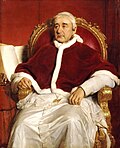Papal States
The Papal States, officially the State of the Church (Italian: [Stato della Chiesa] Error: {{Lang}}: text has italic markup (help), Italian pronunciation: [ˈstato della ˈkjɛːza]; Latin: [Status Ecclesiasticus] Error: {{Lang}}: text has italic markup (help);[2] also Dicio Pontificia), were a series of territories in the Italian Peninsula under the direct sovereign rule of the Pope, from the 8th century until 1870. By 1861, much of the Papal States' territory had been conquered by the Kingdom of Italy. In 1870, the Pope lost Lazio and Rome and had no physical territory at all, except the Vatican. Papal States Media
Related pagesReferences
Other websites
Coordinates: 42°49′16″N 12°36′10″E / 42.82111°N 12.60278°E |
||||||||||||||||||||||||||||||||||||||||||||||||||||||||||||||||||||||||||










